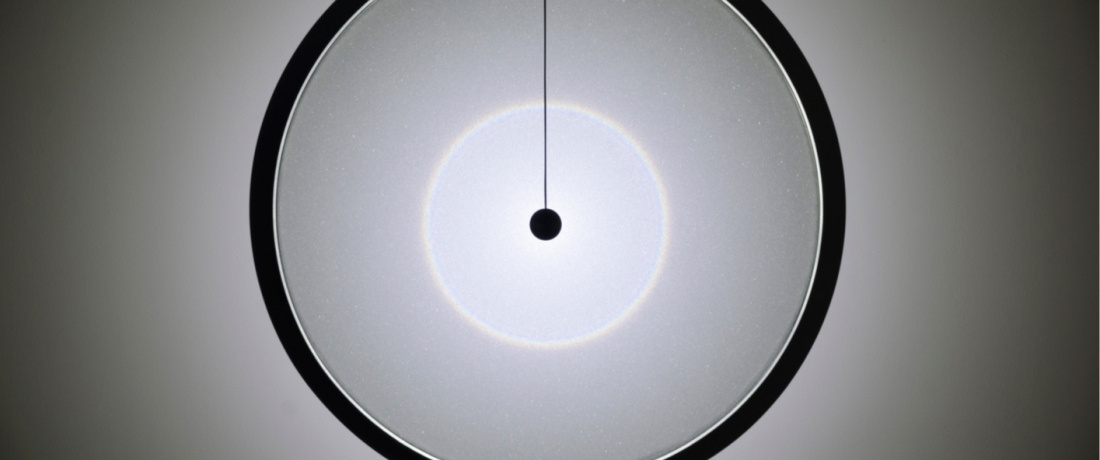Momentum: an experiment in the unexpected
Featured Artworks
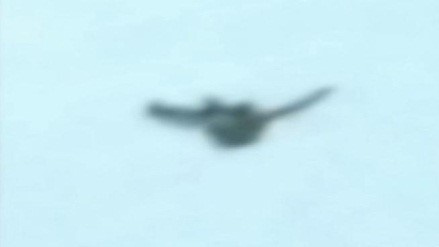
Untitled #8, 2004
Video on DVD
Run time 2 minutes, 31 seconds
Gift of the Moore Family Trust
2014.06
Josh Azzarella
Born 1978, Akron, Ohio
Lives and works in Easton, Pennsylvania
Josh Azzarella’s practice often involves slowing down and abstracting historically significant news footage of tragic events in order to treat the content in a quieter, more contemplative way. Rather than refashioning moments in history, Azzarella layers each individual frame of digital video so that the scene unfolds slowly and what transpired becomes hard to discern. The harrowing work Untitled #8 (2004) shows a dark object in the center of an azure field. The shape, an image of a person jumping from one of the World Trade Center towers on 9/11, slowly morphs and changes but always remains at the center of the screen, endlessly floating.
Big Red, 1959
Metal, wire, and paint on wire armature
Partial and promised gift of Kenneth and Janet Gray Hayes in memory of Margaret Calder Hayes, in honor of the San Jose Museum of Art's 35th anniversary
2005.22
Alexander Calder
Born 1898, Lawnton, Pennsylvania
Died 1976, New York
Although many of Alexander Calder's sculptures from the 1950s were fabricated in factories, Big Red is one of the few mobiles from this period that the artist crafted by hand—even to applying the primary red he came to admire by way of his friend the artist Piet Mondrian (1872 – 1944). "I love red so much," Calder once declared, "I almost want to paint everything red." Over the course of his career, Calder challenged the long-held notion that sculpture was static and stationary. Big Red’s flat, abstract elements are carefully linked together by wire and respond to the subtlest currents of air.
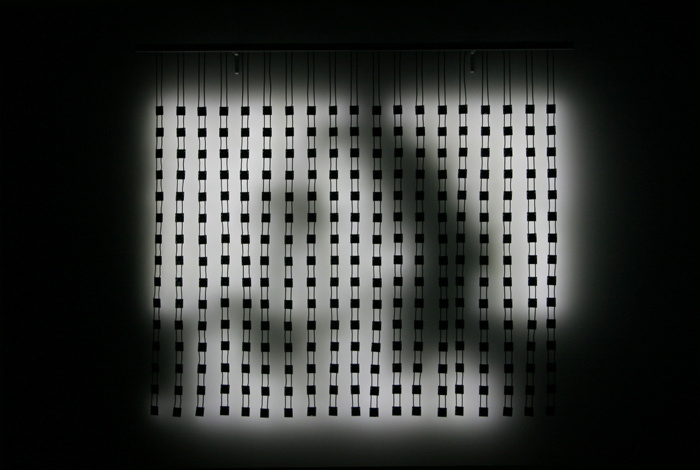
Home Movies 300-3, 2006
LED lights, custom electronics, wire
Gift of Deborah and Andy Rappaport and the Lipman Family Foundation
2007.19
Jim Campbell
Born 1956, Chicago
Lives and works in San Francisco
The patterns of nature are reflected in some physical manifestations of human life; for example, the motion of ocean waves echoes the measured inhalation and exhalation of breath. In Wave Modulation and Variation (2003), over a twenty-minute period the image of rolling waves gradually slows to a stop and then resumes its natural pace. The cycle, like breathing, varies but is continually repeated. By modulating the speed of his minimal visual content, Campbell has demonstrated how the perception of subtle physical phenomena can elicit emotional reactions. Breath can be controlled to achieve calm and, as here, light, image resolution, and movement can be manipulated to the same effect.
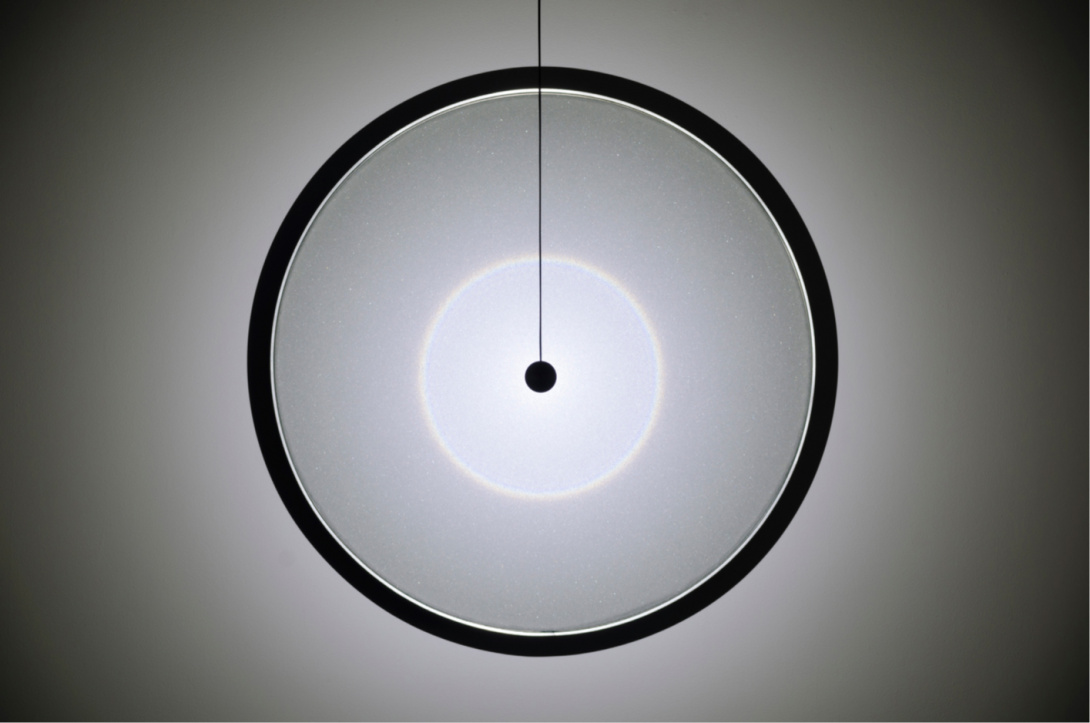
Emmanuelle, 2013
Glass microspheres, plate glass, aluminum disk, and LED lights
Museum purchase with funds contributed by the Council of 100
2014.02
Chris Fraser
Born 1978, Long Beach, California
Lives and works in San Francisco
Chris Fraser is interested in the physiology of human sight. With his installations, he explores the relationship between light and pictures. Fraser discovered glass microspheres while walking on the streets of San Francisco. On the ground, he noticed a halo around the shadow of his head, which followed his every movement. He subsequently learned that miniscule glass spheres are commonly mixed into traffic paint in order to make it reflective. What he experienced was a happy accident: the beads had spilled out everywhere instead of mixing properly into the paint.
Emmanuelle exhibits a unique optical effect through light refraction and the mechanics of human sight. An LED light shines on a surface of glass microspheres, plate glass, and aluminum. The viewer’s movements and changing vantage points cause the optical experience of the sculpture to morph. The halo of the LED is round if the viewer stands parallel to the glass surface, but any motion will bend, break, or even invert the halo into an altogether different visual form. The result is an intimate, personalized encounter with the work.
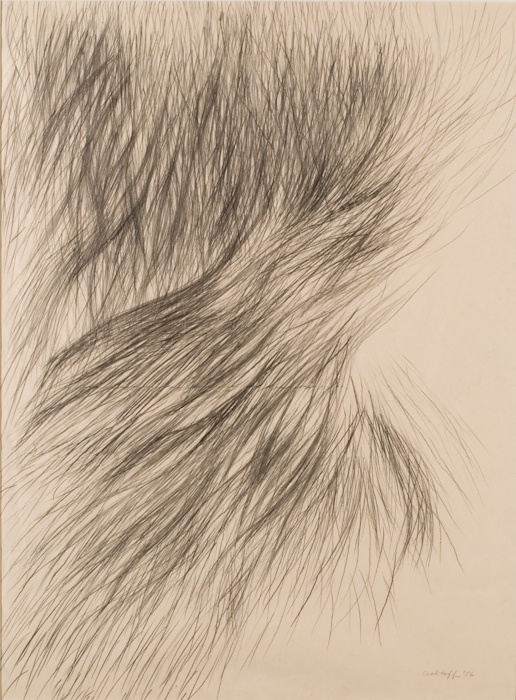
Untitled (Drawing #1), 1956
Graphite on paper
Gift of the artist
2004.02.02
Sonia Gechtoff
Born 1926, Philadelphia
Lives and works in New York
Sonia Gechtoff relies on fluid, sweeping gestures to capture the aesthetic and emotional qualities of the natural environment. In Untitled (Drawing #1), Gechtoff employed graphite’s dark, dramatic properties to capture dynamism in the physical world. Her lines push outward and downward, evoking a torrent of energy.
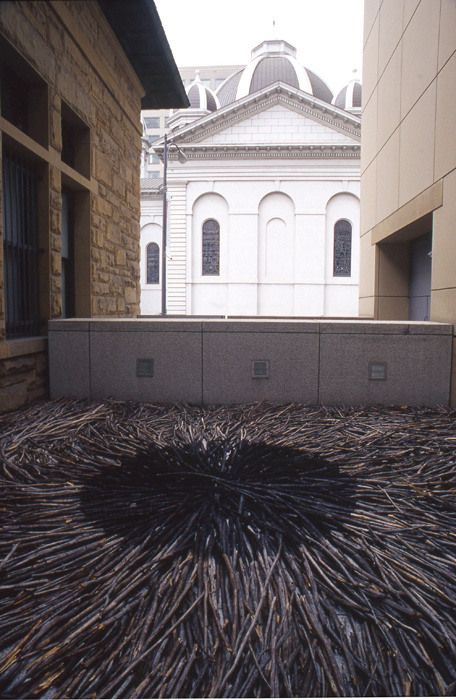
Burnt Patch, SJMA, 1995
Pine sticks from the Sierra Mountains
Gift of Andrew Goldsworthy and Cheryl Haines Gallery
1995.03
Andy Goldsworthy
Born 1956, Cheshire, England
Lives and works in Scotland
Scottish artist Andy Goldsworthy often works outside, collaborating with nature to create uniquely personal and intense artworks. The site-specific installation Burnt Patch was created for the exhibition Andy Goldsworthy: Breath of Earth in 1995. The materials used are from a specific area of the Sierra Mountains near Lake Tahoe; should more be needed, a journey must be made to the site to replenish the installation.
The charred, circular area near the center of the work echoes Goldsworthy's circular works and hole pieces. According to Goldsworthy, "The black of a hole is like the flame of a fire. The flame makes the energy of fire visible. The black is the earth's flame—its energy. I used to say I will make no more holes. Now I know I will always make them. I am drawn to them with the same urge I have to look over a cliff edge. It is possible that the last work I will make will be a hole."
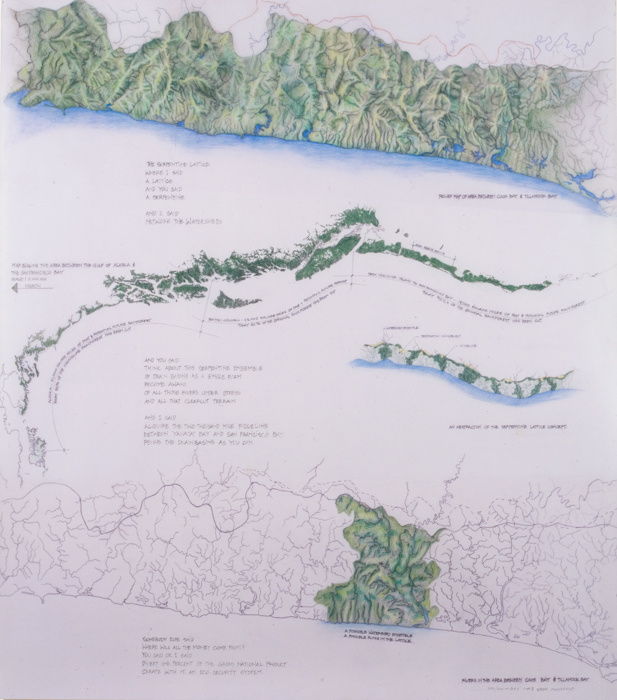
Serpentine Lattice, 1993
Projected images with voice overlay in darkened room
Gift of Helen and Newton Harrison with additional funds contributed by the Museum's Collection Committee
2005.18
Helen and Newton Harrison
Born 1929, New York and 1932, New York
Live and work in Santa Cruz, California
Conceptual artists Helen and Newton Harrison are pioneers in the field of environmental art. In Serpentine Lattice (1993), the husband-and-wife collaborators explored the environmental threats facing the North American Pacific Coast and proposed a revised history for the area. The title refers to the concept for topological restoration embedded within this work. The serpentine is the form resembling the shape of the ridge of the forest from northern California to southern Alaska seen in concert with the shoreline. Bound by the coastal temperate rainforest watersheds to the east, the Pacific Ocean to the west, the Yukutat Bay in Alaska to the north, and the San Francisco Bay to the south, the area represents the fragile remnants of the largest coastal temperate rainforest in the world. Bringing images together with poetry, the artists outlined specific ways that the Serpentine Lattice has changed over time, and offered solutions to reverse the process.
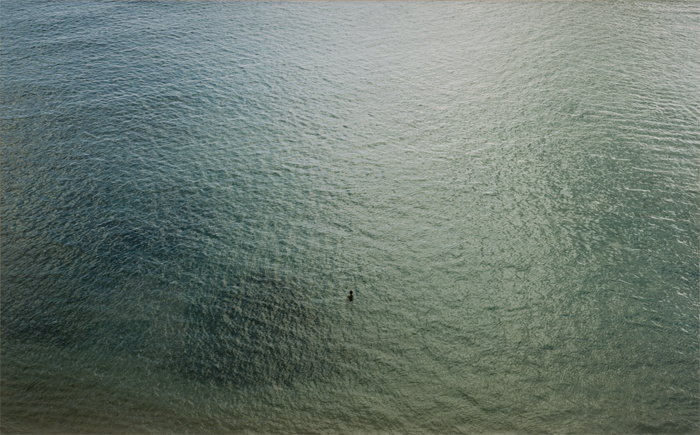
Untitled, from the series “On the Beach,” 2003
Chromogenic print
Gift of the Lipman Family Foundation
2006.13
Richard Misrach
Born 1949, Los Angeles
Lives and works in Berkeley, California
Richard Misrach's photographs reveal a deep concern for contemporary social and political issues, particularly interactions between humans and the natural environment. His "On the Beach" series comprises large-scale, lush color photographs of swimmers and sunbathers in Hawaii. By photographing from above, Misrach created a sense of distance and objectivity: strangely impersonal, isolated figures within seemingly idyllic environments. Misrach began the series shortly after September 11, 2001, the tragic event that "changed the way I looked at everything."
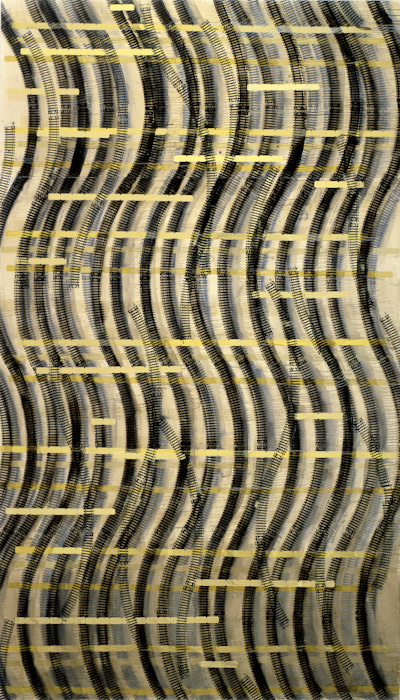
Amusement, 1997
Oil on canvas
Museum purchase with funds contributed by the Council of 100
1998.01
Deborah Oropallo
Born 1954, Hackensack, New Jersey
Lives and works in Berkeley, California
An example of Deborah Oropallo's "flat paintings," Amusement (1997) brings together digital imaging, printmaking, and traditional painting techniques. In a repetitive pattern, Oropallo silk-screened her images onto the canvas then painted over them with oil paint; the result is a dynamic, "push-pull" pictorial space. Here, the curve of a toy train track is flipped back-and-forth until a wave pattern emerges, and yellow ticket stubs crisscross into a basket weave. They seem like the things she passes by, plays with, trips over, picks up, puts away, and frets about every day—prosaic points of contact with her family and friends.
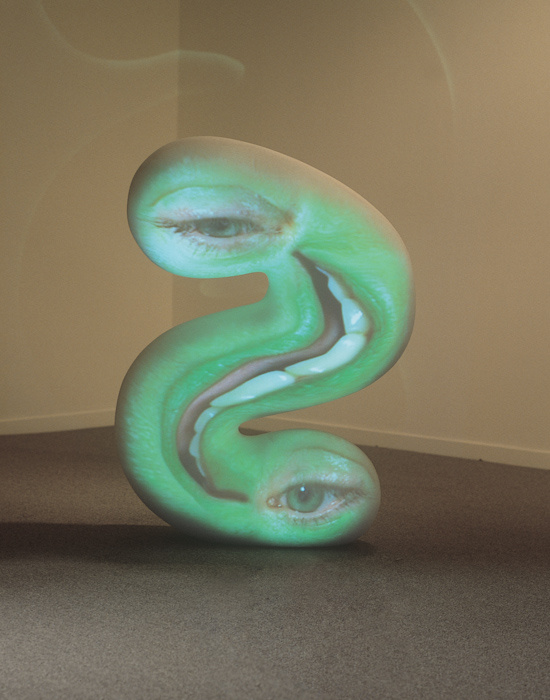
Slip, 2003
Fiberglass sculpture, Sony VPL CS5 projector, DVD, DVD player, and speaker
Gift of the Lipman Family Foundation, in honor of the San Jose Museum of Art's 35th anniversary
2003.32
Tony Oursler
Born 1957, New York
Lives and works in New York
Tony Oursler's subversive objects often explore the pitfalls of human relationships, the psychological effects of technology, and our feelings of alienation from society. He capitalizes on our desire to be entertained by the images we consume, even as they consume us.
In Slip (2003), the projected video image whispering unintelligible phrases accented by elongated "sss" sounds establishes an intriguing connection between the sculpture’s title and its serpentine form. Despite its bizarre appearance and disturbing utterances, Slip retains enough connection to the natural world to suggest a living—albeit alien—creature.
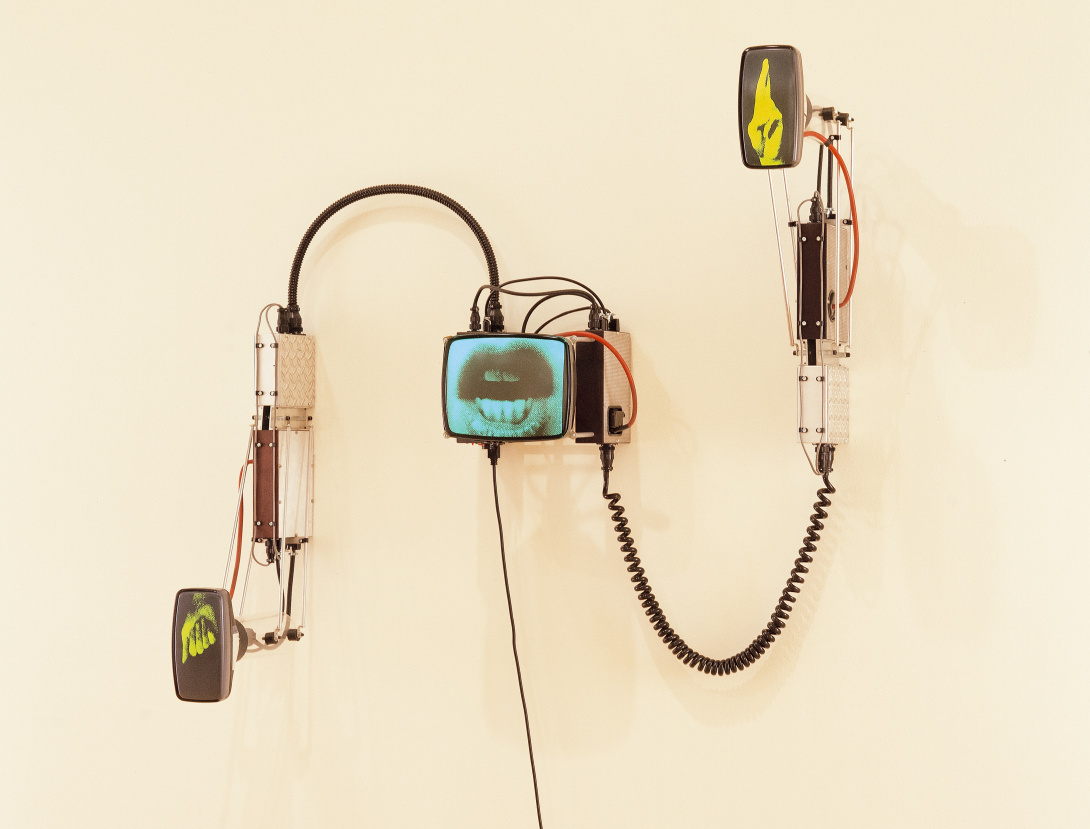
Info Glut II, 1997
Aluminum, acrylic, electronics, and three cathode ray tubes
Museum purchase with the support of Katie and Drew Gibson
1997.12
Alan Rath
Born 1959, Cincinnati
Lives and works in San Francisco
This electronic sculpture is intended as a metaphor for the vast sea of information that engulfs us in our technological age. Info Glut II (1997) uses American Sign Language to communicate a litany of catch-phrases and other useless information such as "batteries not included" and "objects in mirror are closer than they appear." It also communicates the work's title and date and the artist's height, weight, and hair color; it eventually degenerates into, "blah, blah, blah…." Alan Rath seems to warn that if we do not challenge ourselves to synthesize and prioritize this data, we all risk becoming "Info Gluts."
